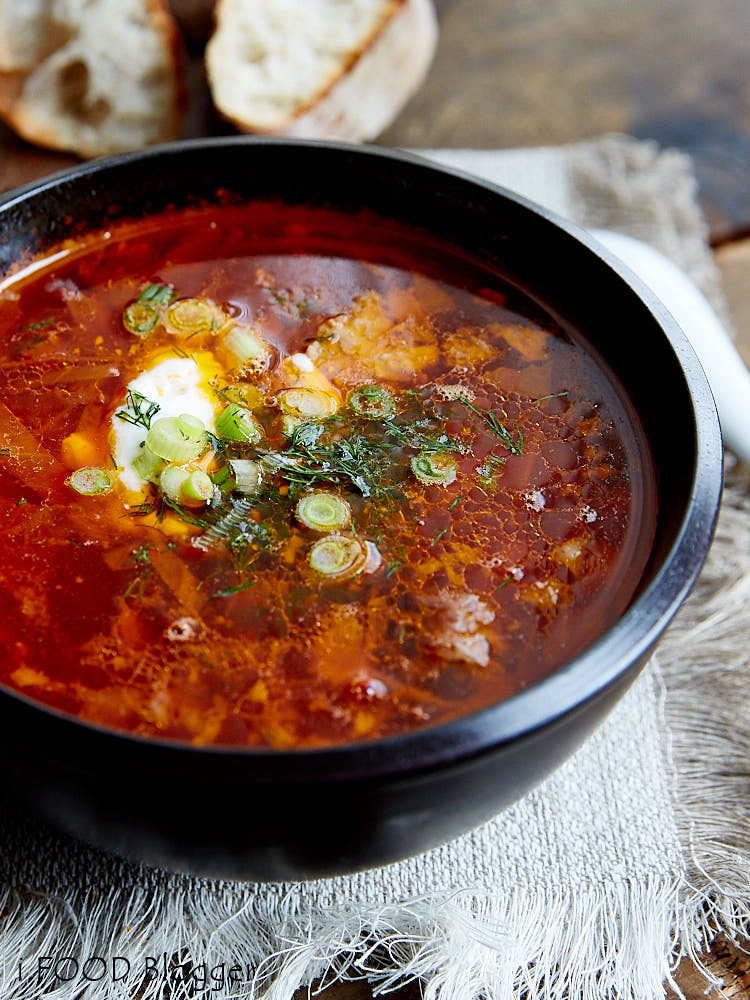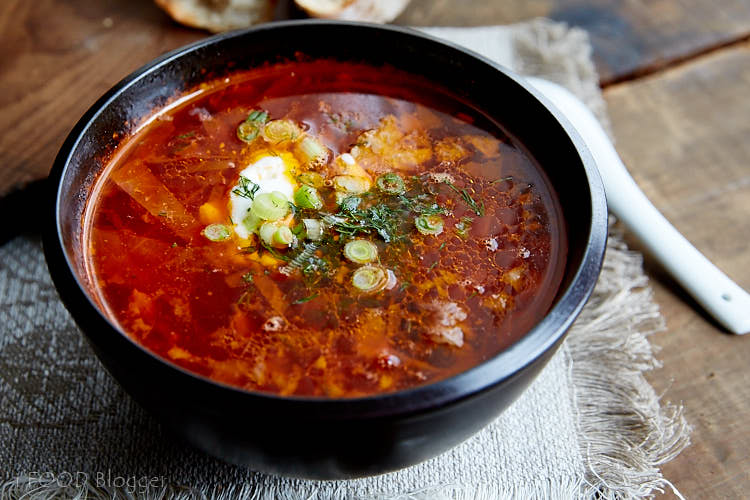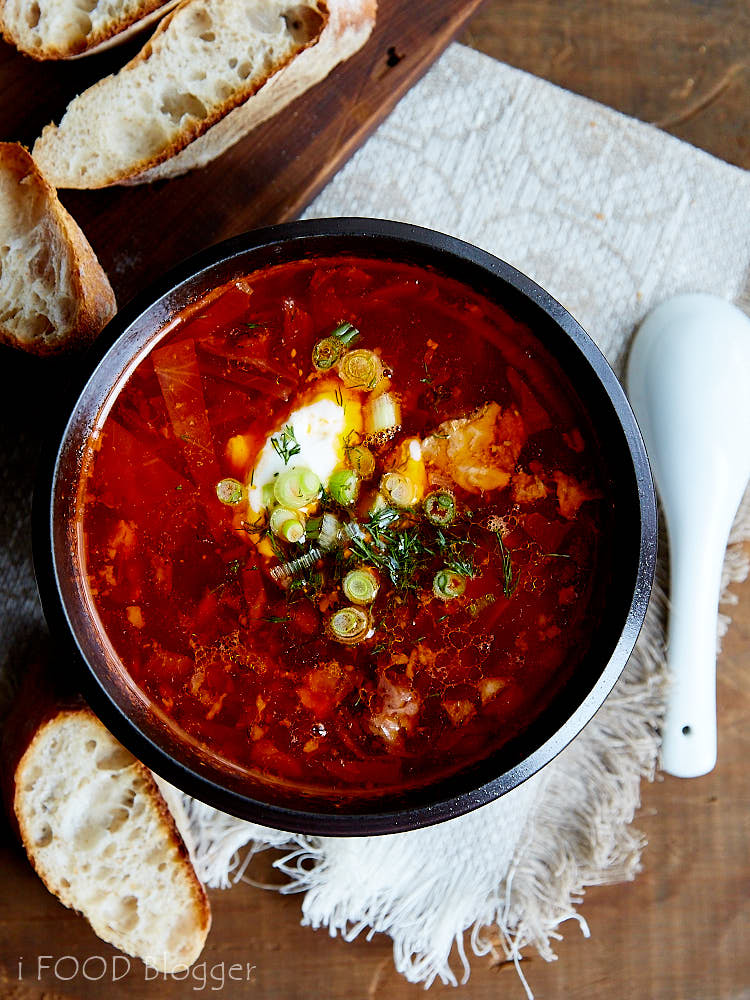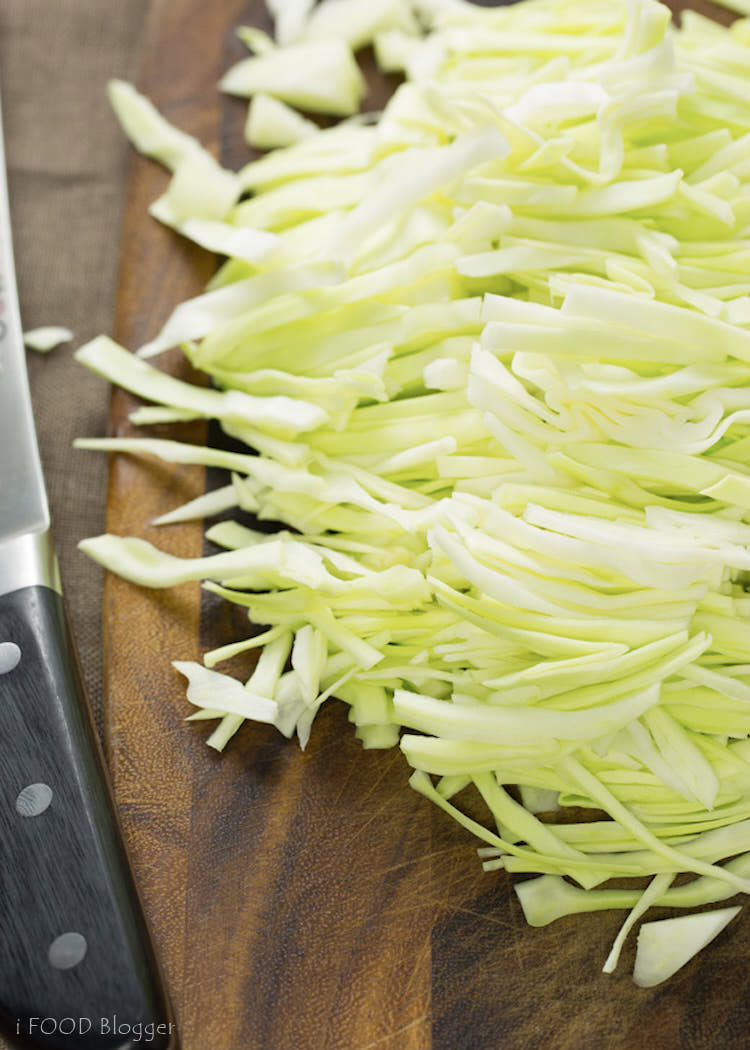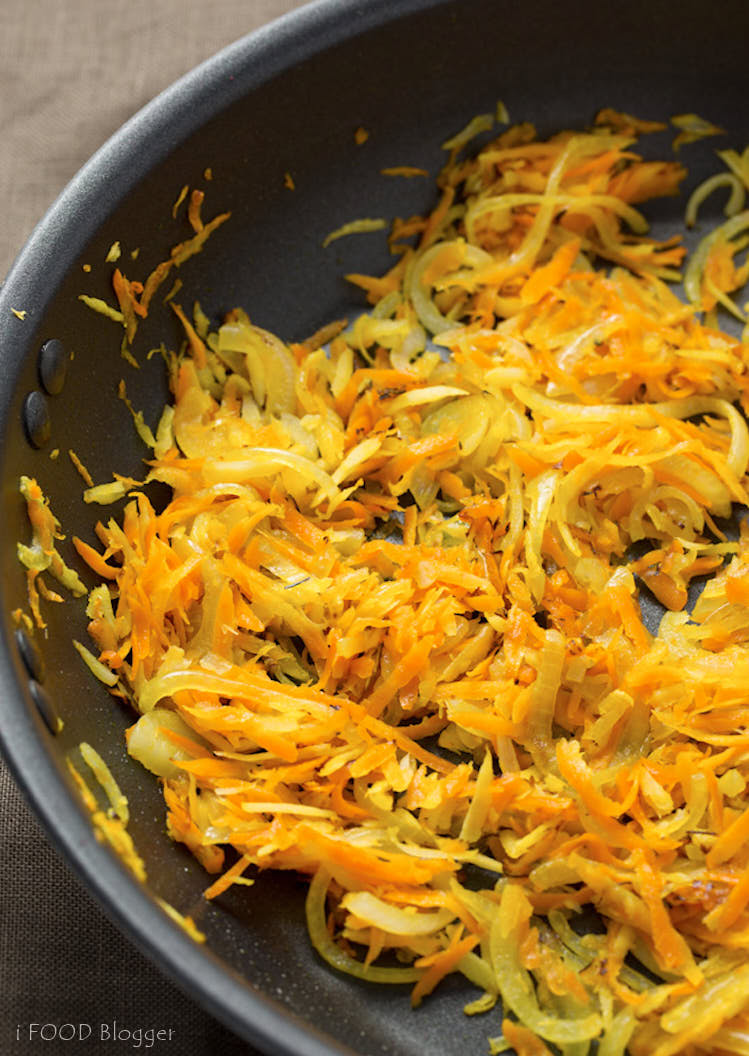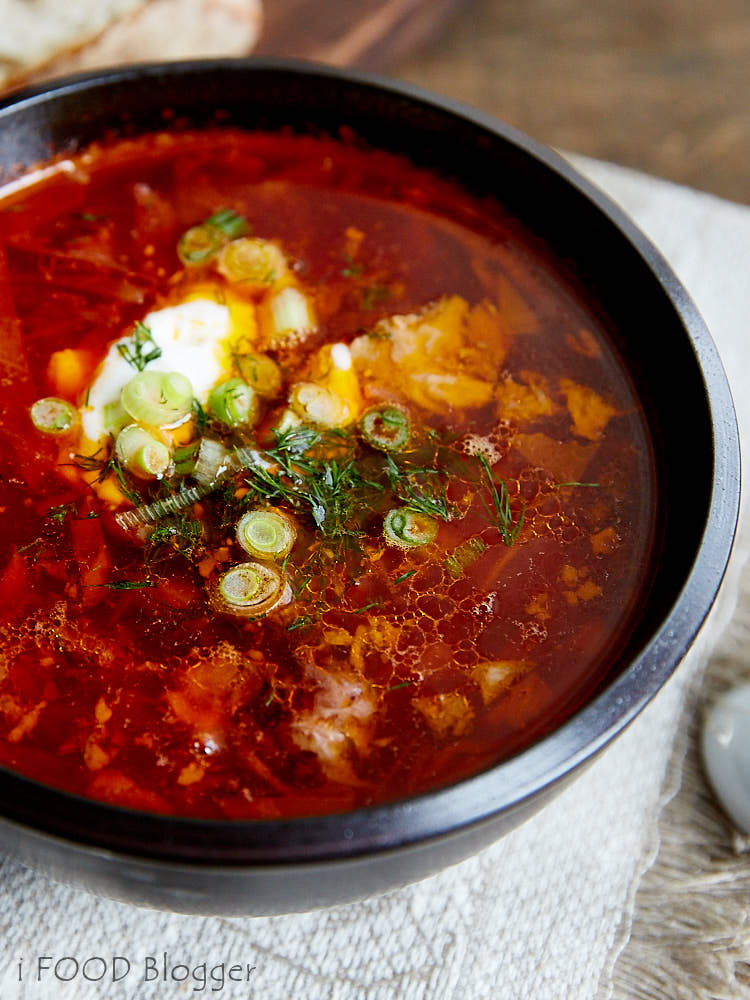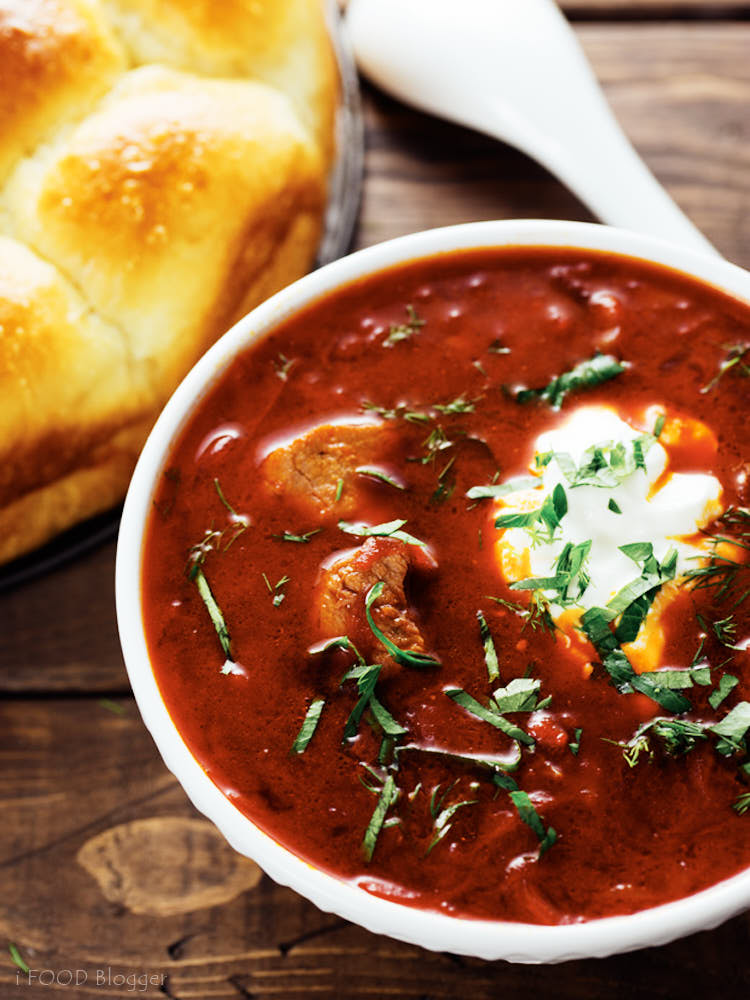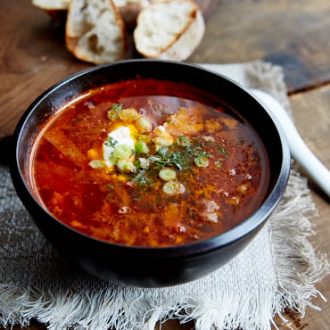Borsch (also known as borscht or borshch) is a traditional Ukrainian soup that is hearty, satisfying and full of vitamins. The sweet and tart taste of borsch pleasantly tickles your taste buds and makes you crave for more. It’s typically served with Pampushki – soft pull-apart garlic rolls – or crusty sourdough bread. In Ukraine borsch is often served as a two-course meal – a soup and a main course consisting of meat taken out of borsch with some side dish added to it. You can skip a salad too considering the amount of veggies you will find in borsch.
A few words on making borsch
Traditional Ukrainian borsch typically does not have a deep purple color, the color of beetroot soup or ‘svekolnik’ as they call it. Instead, it has more of a reddish and dark orange color to it. Borsch is usually associated with traditional Ukrainian cuisine, though other Slavic countries have long had this dish in their menus. Variations of borsch recipes are endless, there are no two that are the same, and every cook has own unique recipe. Making borsch is quite time consuming, but definitely worth it. Hopefully this post will help make the cooking process a little easier and reveal a few tips that that will help make your dish a tad tastier. Fresher and better quality ingredients will make for better borsch, it goes without saying. Make sure you have all your ingredients prepared before cooking as it will help the process go a lot faster and smoother.
If you want your borsch to have a brighter color with distinct beetroot taste, use beet varieties that are darker in color (e.g. Bull’s Blood or Cylindra). If just a hint of beets taste is what you are after, pick lighter beet varieties, such as Chioggia or Golden beet. With lighter varieties of beets your borsch will have less of a purple beet color and more of the color of tomatoes and/or tomato paste.
What meat to use for borsch?
Different kinds of meat can be used for borsch. There is no strict rule here whatsoever. Some like to use pork ribs or pork butt, some use chicken or duck meat, while some use smoked meats in their borsch. The meat should be fresh and well rinsed before cooking, and free of sinew. Ukrainians love the meat to have some fat on it, but this is optional. My personal favorite is pork butt with fat trimmed off to bare minimum.
Making broth – the foundation of borsch
Borsch base is the broth. Good broth is essential for good borsch. Broth should be ‘strong’, meaning it should have full body, good mouth feel, and some thickness to it. To get that meat and bones should cook for at least 2 and up to 3 hours. I never have patience to go that far, stopping typically at about 1.5 hours. Broth should be tasty and flavorful. This is achieved by cooking it over low heat. Gentle simmer is what you want. Vigorous boiling will also cause broth become dull and cloudy, you want to avoid that. Beautiful coloration is achieved by adding a whole onion and a carrot. Aromatic qualities are achieved by adding spices of choice. I usually only add whole black peppercorns and bay leaves.
Finally, it’s recommended that before use the broth is filtered through cheesecloth.
Traditional borsch spices
Traditionally, few spices are added to borsch. Commonly used ones are bay leaf, black pepper, garlic and greens, such as dill, green onions, and parsley. Some cooks choose to add other spices, but do so cautiously, so as not to overpower the natural flavors of borsch.
Important borsch making steps
The order in which ingredients are added to borsch are also important. So, here is how to make borsch in 5 easy steps following the traditional sequence: Salt and acidic ingredients are typically added towards the end of cooking. If added too early in the process, they will prolong the cooking of potatoes and the cabbage, making them overly soft and mushy. Adding spices and garlic at the end ensures that they don’t release too much of their flavor into borsch and don’t overpower it.
Balance of sweet and tart in borsch
Borsch should have a full body and certain thickness to it, be slightly sweet and tart, and have a pronounced taste of vegetables. Starchy ingredients such as potatoes and good ‘strong’ broth add to the body of borsch. Sweetness is achieved by adding beets and sugar, which is often added at the time of stewing beets to help retain their deep color. Moderation is key here, you don’t want your borsch overly sweet. Sometimes sweet bell peppers are added to borsch, in which case less sugar is used. Tartness is achieved by adding vinegar which is added during stewing of beets, tomatoes and/or tomato paste. Balance of sweet and tart is crucial, one should not overpower the other.
Greens help bring out the flavor. Usually fresh dill, parsley, scallions and celery are used.
Borsch color
Ideally the color of borsch should be deep and saturated. The color may vary from light red to dark red depending on the quantity of beets and how long they were cooked. The longer they cook, the more color they will give off to borsch. Sometimes certain ingredients are added to borsch specifically to achieve desired color. Those can be beet juice, tomato juice, cranberry or black currant juice.
Thickness of borsch
Good borsch, they say, should be thick. Some say that it should be thick to the point where if you stick a spoon in it, it should not fall. Thickness in borsch is achieved by ‘strong’, saturated broth and proper amount of certain ingredients, such as cabbage. It’s not uncommon for flour to be added to thicken borsch. Here is the picture of the thick borsch that I am talking about. I added a little bit of flour to thicken it, and used a fairly ‘strong’ broth. My family prefers a less thick version so I don’t make it like that often, but it’s soooooo good.
All that said, borsch should not be mushy and puree-like. All ingredients should maintain their shape and cabbage should have a slight crunch.
Serving traditional borsch
Commonly borsch is served hot. Keep in mind that borsch has good keeping qualities and will keep well in a fridge for several days, and even longer if the meat is removed. A common saying in Ukraine is ‘good borsch is yesterday’s borsch’, meaning that borsch only benefits from sitting in a fridge for a day or two which helps it develop better flavors. Traditional borsch is often served with Pampushki (Ukrainian garlic rolls) and sour cream.
